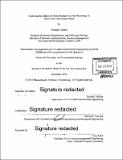| dc.contributor.advisor | Edward F. DeLong. | en_US |
| dc.contributor.author | Valliere, Michael (Michael Finian) | en_US |
| dc.contributor.other | Massachusetts Institute of Technology. Department of Civil and Environmental Engineering. | en_US |
| dc.date.accessioned | 2017-02-22T19:02:04Z | |
| dc.date.available | 2017-02-22T19:02:04Z | |
| dc.date.copyright | 2016 | en_US |
| dc.date.issued | 2016 | en_US |
| dc.identifier.uri | http://hdl.handle.net/1721.1/107068 | |
| dc.description | Thesis: Ph. D. in Environmental Biology, Massachusetts Institute of Technology, Department of Civil and Environmental Engineering, 2016. | en_US |
| dc.description | Cataloged from PDF version of thesis. | en_US |
| dc.description | Includes bibliographical references (pages 131-145). | en_US |
| dc.description.abstract | Photoheterotrophic microbes use proteorhodopsin (PR) and other types of microbial rhodopsin photosystems to harness energy directly from sunlight. This thesis explores the photophysiology of PR in the context of a natural marine isolate, Dokdonia sp. strain MED 134, and by establishing Escherichia coli as a heterologous host to experimentally determine conditions under which the PR photosystem is capable of enhancing growth rate and yield. In Dokdonia sp. MED 134, PR and 11 other genes were discovered to be significantly induced by light but the induction of these genes increased growth rate and yield in an extremely carbon-limited environment; in richer media the induction of the genes by light had an inhibitory effect on growth. In E. coli, various genetic backgrounds were tested with PR expression, and one was discovered to exhibit slightly higher cell yields presumably as a result of light-driven proton pumping by PR. This work illustrates that PR is part of orchestrated response to light in a PR-containing isolate, but can also influence the growth of a heterologous host on its own. Further refinement of the genetic background of E. coli should unlock the full potential of PR as a cellular energy source for biotechnological applications-at least within this organism. | en_US |
| dc.description.statementofresponsibility | by Michael Valliere. | en_US |
| dc.format.extent | 180 pages | en_US |
| dc.language.iso | eng | en_US |
| dc.publisher | Massachusetts Institute of Technology | en_US |
| dc.rights | MIT theses are protected by copyright. They may be viewed, downloaded, or printed from this source but further reproduction or distribution in any format is prohibited without written permission. | en_US |
| dc.rights.uri | http://dspace.mit.edu/handle/1721.1/7582 | en_US |
| dc.subject | Civil and Environmental Engineering. | en_US |
| dc.title | Exploring the effects of proteorhodopsin on the physiology of native and heterologous hosts | en_US |
| dc.type | Thesis | en_US |
| dc.description.degree | Ph. D. in Environmental Biology | en_US |
| dc.contributor.department | Massachusetts Institute of Technology. Department of Civil and Environmental Engineering | |
| dc.identifier.oclc | 971130269 | en_US |
